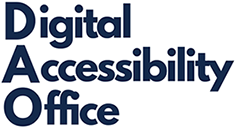Transcripts
What are transcripts?
Transcripts are a text version of the speech and non-speech audio information needed to understand the content.
Types of transcripts
Basic transcripts provide the text version of audio content in a video. NPR’s interview, For Author Kevin Wilson, Writing Offers A Brief Reprieve From Tourette’s, is a good example of a basic transcript.
Descriptive transcripts also include text description of the visual information presented in the video. Descriptive transcripts are required to provide video content to people who are both Deaf and blind.
Interactive transcripts are time-synchronized allowing users to search the spoken audio of a video. They can play the video from any point by clicking within the interactive transcript. This type of transcript is a feature of some media players. Aimee Mullins’s My 12 Pair of Legs TEDTalk is a good example of an interactive transcript because the words highlight in time with the progression of the video.
When are transcripts required?
All media with audio content should include a transcript. Audio only content (e.g., podcast) requires transcript. You should post text transcript along with the audio recording. Posting a transcript also makes your video keyword searchable. Search engines will index it, which improves functionality for all users.
Impact on users
Transcripts help users who are:
- Deaf
- have difficulty seeing visual information
- have multiple disabilities like deaf-blindness
Transcript best practices
Speaker identification
The transcript should include speaker identification like [Instructor] or [Dr. Gus]. It should also include non-speech sounds, like [Phone rings], [sneeze], or [classical music].
Sound identification
Some sounds can have significant impact in the video. Add them to the transcript using the following formatting:
- Use [ ] to surround the sound description
- [Upbeat music playing]
- Italics
Time stamps
Less is more when it comes to timestamps in transcripts. While helpful when locating information in the corresponding video, timestamps can become distracting. Consider adding a timestamp when there’s a:
- Significant change in speaker
- Topic change
- Slide change
Title the transcript
Add the video title as the document properties title and the heading 1 of your document. Readers will be able to tell which video corresponds with the transcript.
Recommended tools
Some of these tools use automatic speech recognition, which can be a starting point for your transcript. You must review and correct any errors from the automatic tool because they are never 100% accurate.
Need help?
If you have questions or concerns, you can submit an online help request for a consultation with the Digital Accessibility Office.
